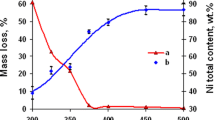Abstract
The structure of niobium nanopowders (particle size 0.03–0.07 μm) oxidized in air is studied by X-ray diffraction. The nanopowder particles have a significant fraction of an amorphous phase. The amorphous component is likely to block the well-known mechanism of niobium oxidation Nb → Nbs.s → Nb6O → NbO → NbOx, which was proposed on the basis of the results of studying the oxidation of niobium powders at high temperatures. Here, Nbs.s is the solid solution of oxygen in niobium and NbOx are the higher niobium oxides NbO2 and Nb2O5. The amorphization of the surface of niobium nanopowders oxidized at 20°C can be one of the main causes of a rather high electrical resistivity (ρ ≈ 108 Θ cm) of the samples compacted from these powders.
Similar content being viewed by others
References
T. Hurlen, “Oxidation of Niobium,” J. Inst. Metals 89(8), 273–278 (1961).
G. Brauter, H. Muller, and G. Kuner, “Oxide der Tieftemperaturooxydation von Niob and Tantal,” J. Less-Common Metals, No. 4, 533–546 (1962).
F. Fairbrother, The Chemistry of Niobium and Tantalum, (Elsevier, Amsterdam, 1967; Khimiya, Moscow, 1972).
V. V. Grinevich, M. S. Model’, A. V. Arakcheeva, et al., “New Oxide Phases of Niobium,” Dokl. Akad. Nauk SSSR 319(2), 389–394 (1991).
V. I. Kobyakov and V. N. Taranovskaya, “Structure and Properties of Oxygen-Containing Niobium Crystals,” Kristallografiya 44, 1017–1023 (1999) [Crystallogr. Rep. 44, 948–954 (1999)].
A. V. Arakcheeva, V. V. Grinevich, Zh. Shapuis, and V. F. Shamrai, “Structure Studies of Solid Solutions of Oxygen in Electrolytic Niobium,” Kristallografiya 47, 272–279 (2002) [Crystallogr. Rep. 47 (2), 237–244 (2002)].
A. V. Arakcheeva, “Crystal Structure of a New Niobium Oxide Nb4O5,” Krystallografiya 37, 589 (1992) [Sov. Phys. Crystallogr. 37, 306 (1992)].
R. J. Cava, B. Batlogg, J. J. Krajevski, et al., “Antiferromagnetism and Metallic Conductivity in Nb12O29,” Nature 350, 598–600 (1991).
A. V. Mitin, G. M. Kuzmicheva, and E. P. Khlybov, “Excess Conductivity at T ≤ 60 K in the Nb-O System,” Sverkhprovodimost’ 5(1), 193 (1992).
Ya. M. Umanskii, X-ray Diffraction of Metals (Metallurgiya, Moscow, 1967) [in Russian].
Author information
Authors and Affiliations
Corresponding author
Additional information
Original Russian Text © V.F. Shamrai, Yu.V. Blagoveshchenski, A.S. Gordeev, A.V. Mitin, I.A. Drobinova, 2007, published in Metally, 2007, No. 4, pp. 77–82
Rights and permissions
About this article
Cite this article
Shamrai, V.F., Blagoveshchenski, Y.V., Gordeev, A.S. et al. Structural states and electrical conductivity of oxidized niobium nanopowders. Russ. Metall. 2007, 322–326 (2007). https://doi.org/10.1134/S0036029507040106
Received:
Issue Date:
DOI: https://doi.org/10.1134/S0036029507040106




